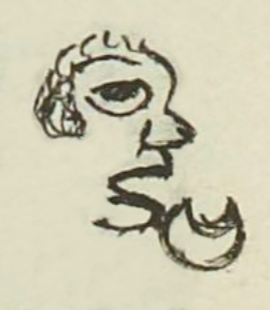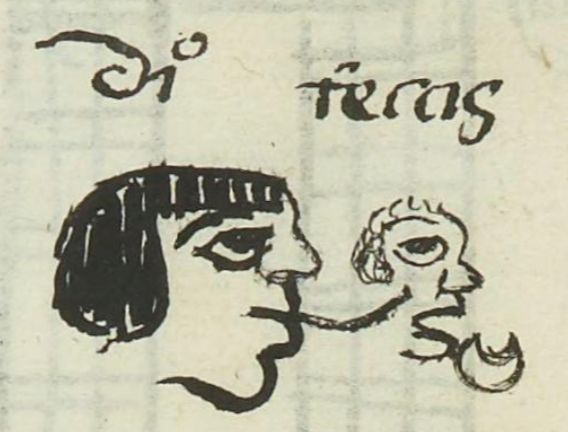Tencax (MH604r)
This black-line drawing of the compound glyph for the personal name Tencax (“Bowl-Lipped," attested here as a man’s name) shows a profile view of the head of a man facing toward the viewer's right. His mouth is open, which draws attention to his lips and chin. Next to his lower lip (tentli) is a bowl (caxitl). It is something of a crescent shaped-bowl (akin to the region's way of showing the number fifteen, caxtolli, which starts with "cax-" as caxitl does. The man's hair is unusual, and his eye is large and wide open. So, the method of his representation would seem to be othering him somewhat. So, perhaps "Bowl-Lipped," is meant and seen as a kind of deformity or notable feature of the person's appearance.
Stephanie Wood
There is an adjective "tencaxtic," apparently used to call someone bowl-lipped. In the gloss, the "n" of Ten- is missing. We have assumed that the omission was inadvertent, and therefore, Tencax ("Bowl-Lipped") was intended. Otherwise, it could be Tecax ("Stone-Bowl"), with the lips providing a phonetic indicator for stone. Still, stones are easily drawn, and so if the artist wished to convey something about stone, it would be strange not to have drawn one.
Having some kind of physical abnormality could have been a plus. Ben Leeming has written about people with deformities in Nahua culture as "morally neutral, supernaturally powerful, and ultimately essential members of the Mesoamerican sacred realm." [See: “Big-Old Long Lips, Big-Old Jar Nose": Ancient Mesoamerican Monsters and Clowns and the Transformation of Christianity in Early Colonial Mexico," Ancient Mesoamerica 33:2 (Summer 2022).
Stephanie Wood
dio tecas
Diego Tecax
Stephanie Wood
1560
Stephanie Wood
labios, caxitl, cajetes, media luna, cuencos, nombres de hombres

ten(tli), lip, https://nahuatl.wired-humanities.org/content/tentli
cax(itl), bowl, https://nahuatl.wired-humanities.org/content/caxitl-0
tencaxtic, bowl-lipped, https://nahuatl.wired-humanities.org/content/tencaxtic
caxtol(li), fifteen, https://nahuatl.wired-humanities.org/content/caxtolli
Labio de Cuenco
Stephanie Wood
Matrícula de Huexotzinco, folio 604r, World Digital Library, https://www.loc.gov/resource/gdcwdl.wdl_15282/?sp=290&st=image.
This manuscript is hosted by the Library of Congress and the World Digital Library; used here with the Creative Commons, “Attribution-NonCommercial-ShareAlike 3.0 License” (CC-BY-NC-SAq 3.0).





